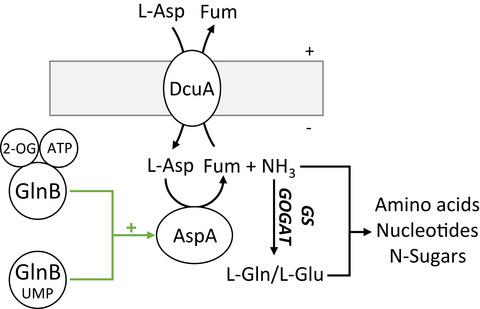当前位置:
X-MOL 学术
›
Mol. Microbiol.
›
论文详情
Our official English website, www.x-mol.net, welcomes your
feedback! (Note: you will need to create a separate account there.)
L‐Aspartate as a high‐quality nitrogen source in Escherichia coli: Regulation of L‐aspartase by the nitrogen regulatory system and interaction of L‐aspartase with GlnB
Molecular Microbiology ( IF 2.6 ) Pub Date : 2020-10-04 , DOI: 10.1111/mmi.14620 Christopher Schubert 1 , Sandra Zedler 1 , Alexander Strecker 1 , Gottfried Unden 1
Molecular Microbiology ( IF 2.6 ) Pub Date : 2020-10-04 , DOI: 10.1111/mmi.14620 Christopher Schubert 1 , Sandra Zedler 1 , Alexander Strecker 1 , Gottfried Unden 1
Affiliation

|
Escherichia coli uses the C4‐dicarboxylate transporter DcuA for L‐aspartate/fumarate antiport, which results in the exploitation of L‐aspartate for fumarate respiration under anaerobic conditions and for nitrogen assimilation under aerobic and anaerobic conditions. L‐Aspartate represents a high‐quality nitrogen source for assimilation. Nitrogen assimilation from L‐aspartate required DcuA, and aspartase AspA to release ammonia. Ammonia is able to provide by established pathways the complete set of intracellular precursors (ammonia, L‐aspartate, L‐glutamate, and L‐glutamine) for synthesizing amino acids, nucleotides, and amino sugars. AspA was regulated by a central regulator of nitrogen metabolism, GlnB. GlnB interacted with AspA and stimulated its L‐aspartate deaminase activity (NH3‐forming), but not the reverse amination reaction. GlnB stimulation required 2‐oxoglutarate and ATP, or uridylylated GlnB‐UMP, consistent with the activation of nitrogen assimilation under nitrogen limitation. Binding to AspA was lost in the GlnB(Y51F) mutant of the uridylylation site. AspA, therefore, represents a new type of GlnB target that binds GlnB (with ATP and 2‐oxoglutarate), or GlnB‐UMP (with or without effectors), and both situations stimulate AspA deamination activity. Thus, AspA represents the central enzyme for nitrogen assimilation from L‐aspartate, and AspA is integrated into the nitrogen assimilation network by the regulator GlnB.
中文翻译:

L-天冬氨酸作为大肠杆菌中的优质氮源:氮调节系统对 L-天冬氨酸酶的调节以及 L-天冬氨酸酶与 GlnB 的相互作用
大肠杆菌使用 C4-二羧酸转运蛋白 DcuA 进行 L-天冬氨酸/延胡索酸反向转运,这导致在厌氧条件下利用 L-天冬氨酸进行富马酸呼吸以及在有氧和厌氧条件下进行氮同化。L-天冬氨酸代表了一种用于同化的优质氮源。来自 L-天冬氨酸的氮同化需要 DcuA 和天冬氨酸酶 AspA 来释放氨。氨能够通过既定途径提供完整的细胞内前体(氨、L-天冬氨酸、L-谷氨酸和 L-谷氨酰胺),用于合成氨基酸、核苷酸和氨基糖。AspA 受氮代谢的中央调节器 GlnB 的调节。GlnB 与 AspA 相互作用并刺激其 L-天冬氨酸脱氨酶活性 (NH 3-形成),但不是反向胺化反应。GlnB 刺激需要 2-酮戊二酸和 ATP,或尿苷酰化 GlnB-UMP,这与氮限制下氮同化的激活一致。在尿苷酰化位点的 GlnB(Y51F) 突变体中失去了与 AspA 的结合。因此,AspA 代表了一种新型的 GlnB 靶标,它结合 GlnB(带有 ATP 和 2-酮戊二酸)或 GlnB-UMP(带有或不带有效应子),这两种情况都会刺激 AspA 脱氨活性。因此,AspA 代表了从 L-天冬氨酸同化氮的中心酶,并且 AspA 被调节剂 GlnB 整合到氮同化网络中。
更新日期:2020-10-04
中文翻译:

L-天冬氨酸作为大肠杆菌中的优质氮源:氮调节系统对 L-天冬氨酸酶的调节以及 L-天冬氨酸酶与 GlnB 的相互作用
大肠杆菌使用 C4-二羧酸转运蛋白 DcuA 进行 L-天冬氨酸/延胡索酸反向转运,这导致在厌氧条件下利用 L-天冬氨酸进行富马酸呼吸以及在有氧和厌氧条件下进行氮同化。L-天冬氨酸代表了一种用于同化的优质氮源。来自 L-天冬氨酸的氮同化需要 DcuA 和天冬氨酸酶 AspA 来释放氨。氨能够通过既定途径提供完整的细胞内前体(氨、L-天冬氨酸、L-谷氨酸和 L-谷氨酰胺),用于合成氨基酸、核苷酸和氨基糖。AspA 受氮代谢的中央调节器 GlnB 的调节。GlnB 与 AspA 相互作用并刺激其 L-天冬氨酸脱氨酶活性 (NH 3-形成),但不是反向胺化反应。GlnB 刺激需要 2-酮戊二酸和 ATP,或尿苷酰化 GlnB-UMP,这与氮限制下氮同化的激活一致。在尿苷酰化位点的 GlnB(Y51F) 突变体中失去了与 AspA 的结合。因此,AspA 代表了一种新型的 GlnB 靶标,它结合 GlnB(带有 ATP 和 2-酮戊二酸)或 GlnB-UMP(带有或不带有效应子),这两种情况都会刺激 AspA 脱氨活性。因此,AspA 代表了从 L-天冬氨酸同化氮的中心酶,并且 AspA 被调节剂 GlnB 整合到氮同化网络中。









































 京公网安备 11010802027423号
京公网安备 11010802027423号